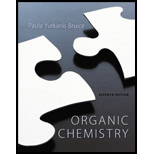
Concept explainers
(a)
Interpretation:
Conjugated organic molecules has to be ranked based on decreasing
Concept introduction:
Conjugation on
HOMO-LUMO: In a
Auxochrome: When the molecule attached to a chromophores group the both
(b)
Interpretation:
Conjugated organic molecules has to be ranked based on decreasing
Concept introduction:
UV/vis spectroscopy: It is deal with information about various compounds that have conjugated double, the UV light and visible light have jest the right energy to cause an electronic transition in a molecule that is to promote an electron from one molecular orbital to another higher energy.
Conjugation on
HOMO-LUMO: In a
Auxochrome: When the molecule attached to a chromophores group the both
Want to see the full answer?
Check out a sample textbook solution
Chapter 14 Solutions
Organic Chemistry; Modified MasteringChemistry with Pearson eText -- ValuePack Access Card; Study Guide and Student Solutions Manual for Organic Chemistry, Books a la Carte Edition (7th Edition)
- Three isomeric compounds, A, B, and C, all have molecular formula C8H11N. The 1H NMR and IR spectral data of A, B, and C are given below. What are their structures?arrow_forwardMuscalure is the sex attractant of the common housefly. Flies are lured to traps filled with bait that contain muscalure and an insecticide. Eating the bait is fatal. How could you synthesize muscalure using 1-bromopentane as one of the starting materials?arrow_forwardAs shown below, when compound 6a is heated, (1Z, 3Z)cycloheptadiene is formed. When the related compound 6b is heated, however, (1E, 3Z)-cyclodecadiene is formed. Explain these results, and suggest a reason why opening of the five-membered ring in 6a needs a higher temperature than that of the eight-membered ring in 6b. (7 points) H 270 °C H 6a 6b H 190 °Carrow_forward
- Rank the following groups in terms of their priority according to the Cahn-Ingold-Prelog system of priorities. Give the highest ranking group a priority of 1 and the lowest ranking group a priority of 4. -D ✓-H ✓-NH₂ ✓-CH₂OHarrow_forwardRank the compounds in each set from most to least reactive in an EAS reactionarrow_forward(2R,3S)-2-Bromo-3-phenylbutane undergoes an E2 elimination when treated with sodium methoxide. Draw all possible Newman projections for the bond relevant for the elimination reaction, and use those Newman projections to explain the stereochemical outcome of the reaction. Draw the final product and provide its IUPAC name.arrow_forward
- Rank the following groups in order of decreasing priority. −COOH, −H, −NH2, −OHarrow_forwardPropose a structure of compound C (molecular formula C10H12O) consistent with the following data. C is partly responsible for the odor and flavor of raspberries. Compound C: IR absorption at 1717 cm–1arrow_forwardCompound O has molecular formula C10H12O and shows an IR absorption at 1687 cm−1. The 1H NMR spectrum of O is given below. What is the structure of O?arrow_forward
